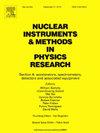FANSIC: A Fast ANalog SiPM Interface Circuit for the readout of large silicon photomultipliers
IF 1.5
3区 物理与天体物理
Q3 INSTRUMENTS & INSTRUMENTATION
Nuclear Instruments & Methods in Physics Research Section A-accelerators Spectrometers Detectors and Associated Equipment
Pub Date : 2025-04-18
DOI:10.1016/j.nima.2025.170523
引用次数: 0
Abstract
Silicon photomultipliers (SiPMs) have increasingly replaced traditional photomultiplier tubes (PMTs) in a wide range of applications, not subject to excessive radiation or extreme temperatures, due to their benefits in terms of compactness, reliability, granularity, lower operating voltage, cost-effectiveness for mass production and photodetection efficiency (PDE). However, for large-area detection systems, PMTs still remain the preferred choice due to their lower thermal noise and the shorter duration of their output signal, both of which degrade in SiPMs as the sensor size increases. Overcoming these limitations is crucial for the adoption of SiPMs in next-generation gamma-ray observatories.
We present FANSIC, a dedicated analog front-end application specific integrated circuit (ASIC) designed to address these challenges and enable the high-speed readout of large-area SiPMs. Developed in 65 nm CMOS technology, FANSIC features an active summation architecture that efficiently combines signals from multiple SiPM channels and mitigates the undesirable effects associated with the capacitance of large sensors. Its functional dynamic range extends up to 800 photoelectrons (p.e.), while a pulse duration of and a post-calibration linearity better than are achieved within the range of interest, which goes up to p.e. These performance are obtained while containing the power consumption to mW per pixel, making FANSIC an ideal choice for experiments in which low-power consumption is critical, like in cameras of large-scale telescopes. Designed for versatility, FANSIC offers single-ended and differential output configurations, ensuring compatibility with various digitization solutions and types of SiPMs. Extensive simulations and laboratory measurements confirm its high performance, demonstrating its potential as a key enabling technology for future Cherenkov telescopes.
FANSIC:用于读出大型硅光电倍增管的快速模拟SiPM接口电路
硅光电倍增管(SiPMs)在广泛的应用中越来越多地取代了传统的光电倍增管(pmt),不受过度辐射或极端温度的影响,因为它们在紧凑、可靠性、粒度、更低的工作电压、大规模生产的成本效益和光探测效率(PDE)方面具有优势。然而,对于大面积检测系统,pmt仍然是首选,因为它们具有较低的热噪声和较短的输出信号持续时间,这两者在sipm中随着传感器尺寸的增加而降低。克服这些限制对于在下一代伽玛射线天文台中采用sipm至关重要。我们提出了FANSIC,一种专用的模拟前端应用专用集成电路(ASIC),旨在解决这些挑战并实现大面积sipm的高速读出。FANSIC采用65纳米CMOS技术开发,具有主动求和架构,可有效地组合来自多个SiPM通道的信号,并减轻与大型传感器电容相关的不良影响。其功能动态范围扩展到800光电子(p.e),而在感兴趣的范围内,脉冲持续时间为3ns,后校准线性度优于±5%,最高可达250p.e。这些性能是在每像素功耗为23mW的情况下获得的,这使得FANSIC成为对低功耗至关重要的实验的理想选择,比如大型望远镜的相机。专为多功能性而设计,FANSIC提供单端和差分输出配置,确保与各种数字化解决方案和类型的sipm兼容。广泛的模拟和实验室测量证实了它的高性能,展示了它作为未来切伦科夫望远镜关键使能技术的潜力。
本文章由计算机程序翻译,如有差异,请以英文原文为准。
求助全文
约1分钟内获得全文
求助全文
来源期刊
CiteScore
3.20
自引率
21.40%
发文量
787
审稿时长
1 months
期刊介绍:
Section A of Nuclear Instruments and Methods in Physics Research publishes papers on design, manufacturing and performance of scientific instruments with an emphasis on large scale facilities. This includes the development of particle accelerators, ion sources, beam transport systems and target arrangements as well as the use of secondary phenomena such as synchrotron radiation and free electron lasers. It also includes all types of instrumentation for the detection and spectrometry of radiations from high energy processes and nuclear decays, as well as instrumentation for experiments at nuclear reactors. Specialized electronics for nuclear and other types of spectrometry as well as computerization of measurements and control systems in this area also find their place in the A section.
Theoretical as well as experimental papers are accepted.

 求助内容:
求助内容: 应助结果提醒方式:
应助结果提醒方式:


